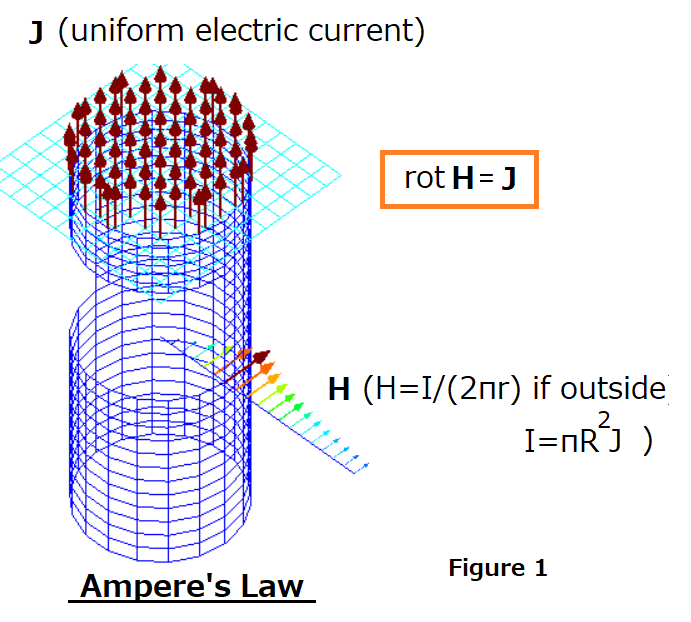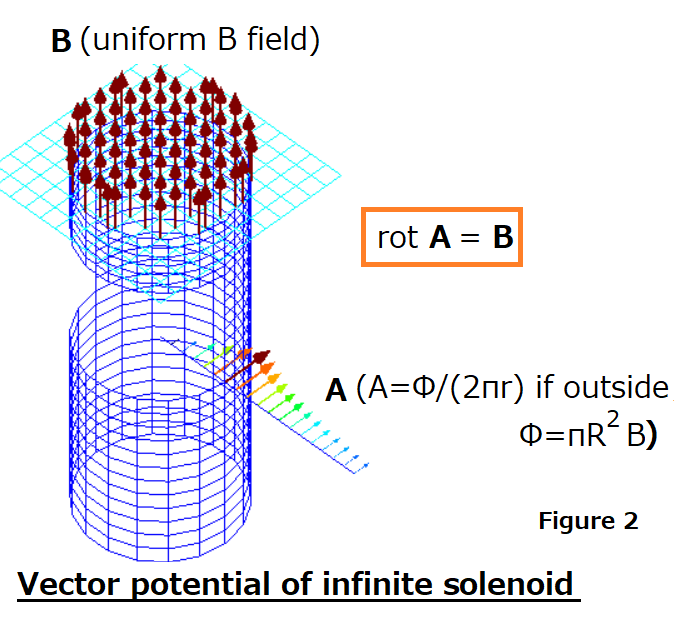Multiplying the equation what I wrote here by the time harmonic oscillation factor $e^{-i\omega t}$,
I believe the analytical solution in vector potential form is given by
$$
A_{\theta}=
\left\{
\begin{alignedat}{2}
& \frac{1}{2}B_z^0re^{-i\omega t} &\quad& \text{for }r\leq R \\
& \frac{1}{2}\left(B_z^0R\right)\frac{R}{r}e^{-i\omega t} & & \text{for } R<r
\end{alignedat}
\right.
$$
From this solution, we obtain $\vec{B}=\vec{0}$ and $\vec{E}=-\frac{\partial \vec{A}}{\partial t}\neq \vec{0}$ outside the solenoid.
Some preliminaries (EDIT; below added on Tue Feb 7 2023)
When writing formulas here, we use cylindrical coordinates.
To investigate the time-varying infinite solenoid problem, the vector potential and scalar potential formulation, that is $(\mathbf{A},\phi)$ formulation, is used to describe it.
If axis symmetry is maintained, the scalar electric potential disappears,
because $\phi(\theta_A)=\phi(\theta_B)$ if $\theta_A\neq\theta_B$.
Thus only $\mathbf{A}$ is the freedom variable to solve for.
And the Coulomb gauge condition $\text{div}\mathbf{A}=0$ is taken into account.
It is important to note that the displacement current is not taken into account here.
Static infinite solenoid
First we consider a static solenoid of infinite length.
But before we go any further, another different problem will be examined, since 2 types of problems are similar in their mathematical formulations,
if one type is verified, the other is straightforward.
Let us review Ampere's law for a conducting cylinder of finite size with a uniform current flowing through its cross-section; this is the 2nd type of problem. The problem and result are summarized in the figure:
this is the 2nd type of problem. The problem and result are summarized in the figure:
Now let us illustrate a similar figure relating to a static infinite solenoid
(this is the 1st primary problem). The problem and result are summarized in the figure:
 As stated above, these 2 problems are similar.
Therefore, similar math expressions exist as shown in the figures.
As stated above, these 2 problems are similar.
Therefore, similar math expressions exist as shown in the figures.
I emphasise important differences between them here.
- $\mathbf{J}$ and $\mathbf{H}$ are observables, and $\mathbf{B}$ is observable but $\mathbf{A}$ is NOT observable.
- $\mathbf{J}$ and $\mathbf{A}$ are vectors while, $\mathbf{H}$ and $\mathbf{B}$ are pseudo-vectors.
Time harmonic varying infinite solenoid
The equation for a time-harmonic oscillating infinite-length solenoid, which I claim to be the solution, was given at the beginning of this note.
Here it is verified that it does indeed satisfy Maxwell's equations.
Since the system is axis symmetric, then
\begin{align*}
\text{rot}\mathbf{A}
&= \left(\frac{1}{r}\frac{\partial A_z}{\partial\theta} -\frac{\partial A_{\theta}}{\partial z},\;
\frac{\partial A_r}{\partial z}-\frac{\partial A_z}{\partial r},\;
\frac{1}{r}\left\{\frac{\partial (rA_{\theta})}{\partial r}-\frac{\partial A_r}{\partial \theta} \right\}\right) \\
&= \left(-\frac{\partial A_{\theta}}{\partial z},\;0,\;
\frac{1}{r}\frac{\partial (rA_{\theta})}{\partial r}\right)
= \left(0,\;0,\;\frac{1}{r}\frac{\partial (rA_{\theta})}{\partial r}\right),
\end{align*}
thus,
\begin{align*}
\mathbf{B}_z&=\left(\text{rot}\mathbf{A}\right)_z=
\left\{
\begin{alignedat}{2}
& B_z^0e^{-i\omega t} &\quad& \text{for }r\leq R \\
& 0 & & \text{for } R<r
\end{alignedat}
\right. \\
&= B_z^01(R-r)e^{-i\omega t},
\end{align*}
where $1(x)$ is the Heaviside step function,
defined as $1(x) = 1\text{ for }x>0\text{ and } 1(x) = 0\text{ for }x\le 0$
and $A_{\theta}(r)$ written at the begininng of this note substituted.
Now let us proceed to the calculation of $\text{rot}\mathbf{H}$.
Magnetic permeability within the solenoid coil is assumed to be isotropic and constant,
that is, it is given as $\mu(r)=\mu_{\text{rod}}1(R-r)$,
where $\mu_{\text{rod}}$ is the constant permeablity in the solenoid rod.
We can get the magnetic H field as follows:
\begin{align*}
\mathbf{H}_z=\frac{1}{\mu(r)}\mathbf{B}_z=
\frac{1}{\mu(r)}B_z^01(R-r)e^{-i\omega t}
=\frac{1}{\mu_{\text{rod}}1(R-r)}B_z^01(R-r)e^{-i\omega t}
=\frac{1}{\mu_{\text{rod}}}B_z^01(R-r)e^{-i\omega t}
\end{align*}
As seen this result, the magnetic field is confined within the solenoid.
The next task is to look for the electric current in this system. Since
\begin{equation*}
\text{rot}\mathbf{H}
= \left(\frac{1}{r}\frac{\partial H_z}{\partial\theta} -\frac{\partial H_{\theta}}{\partial z},\;
\frac{\partial H_r}{\partial z}-\frac{\partial H_z}{\partial r},\;
\frac{1}{r}\left\{\frac{\partial (rH_{\theta})}{\partial r}-\frac{\partial H_r}{\partial \theta} \right\}\right) \\
= \left(0,\;-\frac{\partial H_z}{\partial r},\;0\right),
\end{equation*}
we get
\begin{equation*}
\left.\mathbf{J}\right|_{\theta}=
\left.\text{rot}\mathbf{H}\right|_{\theta}= -\frac{\partial H_z}{\partial r}
= -\frac{\partial}{\partial r}\left(\frac{1}{\mu_{\text{rod}}}B_z^01(R-r)e^{-i\omega t}\right)
= \frac{1}{\mu_{\text{rod}}}B_z^0\delta(r-R)e^{-i\omega t}.
\end{equation*}
That is, the surface current densitiy $\left.\mathbf{J}\right|_{\theta}$ on the solenoid rod surface is calculated.
The space electric fields can be obtained via $\mathbf{E}=-\text{grad}\phi-\frac{\partial \mathbf{A}}{\partial t}$ :
\begin{equation*}
\mathbf{E}_{\theta}=
-\frac{\partial A_{\theta}}{\partial t} =
\left\{
\begin{alignedat}{2}
& \frac{i\omega}{2}B_z^0re^{-i\omega t} &\quad& \text{for }r\leq R \\
& \frac{i\omega}{2}\left(B_z^0R\right)\frac{R}{r}e^{-i\omega t} & & \text{for } R<r
\end{alignedat}
\right.
\end{equation*}
As seen this result, the electric field outside the solenoid is not zero.
Thus the math form $\mathbf{A}$, given at the beginning of this note, satisfies
3 of Maxwell's equations provided the displacement current is neglected, i.e.,
$\text{rot}\mathbf{H}=\mathbf{J}$, $\text{rot}\mathbf{E}=-\frac{\partial\mathbf{B}}{\partial t}$
and $\text{div}\mathbf{B}=0$ are satisfied.
Some comments
It is very interesting that vector $\mathbf{A}$,
expressed with the function
$A_{\theta}\sim\frac{1}{2}\left(B_z^0R\right)\frac{R}{r}$ (for $r<R$),
is whirlpooling but at the same time, rot-operator free
($\text{rot}{\mathbf A}=\mathbf{0}$) and div-operator free ($\text{div}\mathbf{A}=0$).
Further, this function cannot be expressed in terms of $-\text{grad}\Psi$ type expression if $\Psi$ is single valued.
Yes, I agree that the domain is not singly connected.
Outside the static infinite solenoid the magnetic field is 0,
but the vector potential is not zero.
The vector potential outside the solenoid is an unobservable fictitious object if the system is static. But if the system is time-varying, the non-zero electric field outside the solenoid appears as $-\dot{\mathbf{A}}$;
this reminds me of the famous Aharonov-Bohm effect.
Finally, I would like to add a comment about neglecting the displacement current.
The reason we can safely neglect the displacement current is because it is very small in the vicinity of the lab solenoid.
In the Wikipedia article,
there seems to be no concern about the displacement current.



